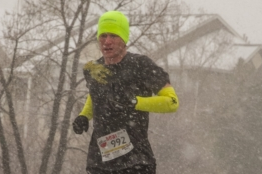GPS watches have gained in popularity for several years now, to the point where I’m pretty sure I was in the minority with my “regular” watch at my local run club. When I first saw GPS watches in the early 2000s, they were brick-sized machines worn on the wrist, or they were a regular-sized watch that took their signal from a large armband which was worn on the upper bicep. Since that time, the designs evolved considerably and they now have the appearance and size of a standard watch. When running with people who use them, it was useful to have distance measurements and to know our overall pace when they called these numbers out. Still, I resisted buying one. My main objection was in wondering whether it would help with my running, and I wasn’t convinced that it would make a substantial difference.
I used Google maps to chart courses and if I was on an unknown route or travelling, I just went by time. My standard training pace is around 7:15-7:30 per mile so I went with 8:00 per mile, figuring that if I was going slow, I would be on target and if I was at my average speed, the extra mileage wouldn’t hurt me.
While it may seem a bit contradictory to be focused on the precision of time and splits in races while then sometimes going with not-so-accurate ways to measure my running distances, I enjoyed the balance. Having a more casual approach to distance measurement was a way to enjoy the freedom of the run without being overly concerned with data. And, my race times were within what I was expecting based on my mileage and speedwork. In other words, the lack of data was not hurting my running in a significant way.
When I’ve run new routes during the pandemic, I wanted to mix things up so I would take random turns or new neighborhood loops mid-run. I used my 8:00 per mile method of measurement and assumed I was logging more miles. When I went on a “six mile” out-and-back run with some friends of mine, well before my usual turnaround point, one of them said, “We’re at three miles.” We turned around and I’m assuming that my past six mile runs on that route had really been closer to seven. While I didn’t mind the extra mileage, this did spark my curiosity on how far I was actually running and whether knowing that in more detail would be beneficial. For example, if my race week mileage was getting a little stretched, maybe that was causing me to lose a few seconds on race day. Not a big deal but like any runner, I want the best time possible. I wouldn’t say I was consciously inching towards acquiring a GPS watch but something in my subconscious must have been pushing me in that direction to where I hit a breaking point and picked one up.
What got me to that point? During a time trial this past summer, I learned that not only could you get your average pace over the total distance of the run, the watch would tell you how fast you were going at that moment. When I went out too fast during the trial, the watch that one of my friends was wearing showed our pace and I was able to back off to the pre-planned speed. Having a good feel for in-run pace can be challenging and being able to see it finally sold me on the idea that the watch’s features would benefit my running and not just be extra data to have on hand.
Besides showing current pace, the watch does allow for some fun and freedom. During my first week with it, I went on two new routes and took random turns and loops, being able to count on the watch to track it without worrying about the number of minutes run, especially if I was changing my pace to observe new direction possibilities. On routes where I know the distance, it’s beneficial to see the pace and the smaller distance increments I’ve covered.
The watch may not allow me to drop minutes off of my 5K time but it will allow me to explore new routes and know what my total mileage is. I’ll have a better sense of how fast (or slow) I’m going in-run as opposed to getting that data at mile-markers or other landmarks. It may not completely transform me as a runner (nor would I want it to) but it will help nudge me into having a little more knowledge, and thus increase my chances of better results, even if they are small improvements.

Running anecdotes, running food reviews, some race coverage, and more